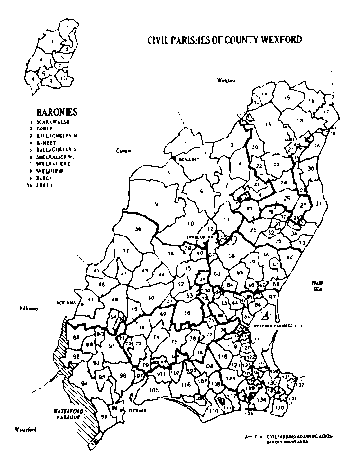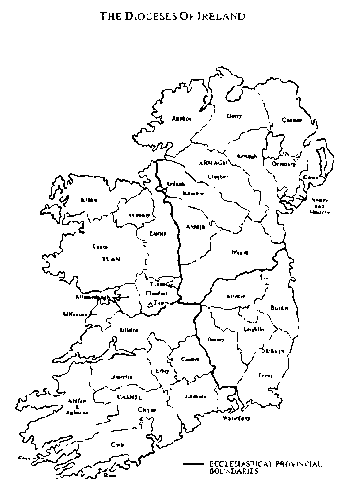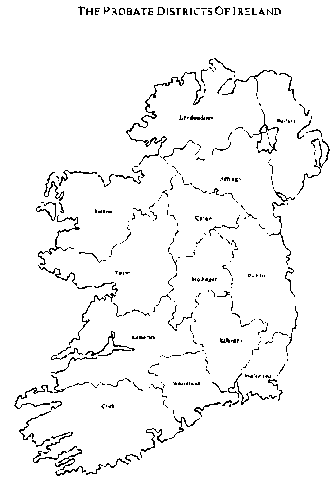[ Home | Links | Schedule | Status | Archive | Family Tree | Discussions ]
Boundries: Townland Parish Baroney Diocese Poor Law Union Probate Districts
Data: 1817-Emmigrants 1820 1821-census Householders Index 1842-Voters List 1853-Griffith 1861-census 1867-census 1876-Householders
Irish Boundries in 1800's: |
Townland Parish Baroney
A. Townland
The Naming of the Land
Bagley (p11) says that "the Irish people have been inclined
to lavish names on their land. There is scarcely a rock or clump
of trees or path that goes unnamed. Each of the fields comprising
a farm has its own name, e.g. the river field, the chapel field,
the road field, the coursing field, the bush field, the nine
acres and so on. Ten or fifteen contiguous farms go to make a
townland -- the smallest administrative unit of land in
Ireland". I can verify that. Ancesotrs on the old homestead
(from 1860s's) had given names to hills (Tom's hill, Dan's hill),
bends in the road, and lookouts (eg. the Vineyard-but no grapes
were grown).
He on the same page describes Townland in the following three
paragraphs:
Townland
"The geographic term 'townland' arose from an unfortunate
official translation of the Gaelic baile fearainn meaning
'homestead land'. There is here no question of a township or
urban centre of any kind. The confusion probably arose because of
a later and secondary meaning ascribed to the word baile --
usually rendered 'Bally' in the English language -- equating it
with 'village', 'town' and 'city'. The place-name prefix 'Bally-'
occurs in about 6,500 townlands or one in every ten townlands in
Ireland. Other high frequency townland prefixes include Cill --
Kill, meaning a church; Cnoc - Knock, a hill; Lios - Lis(s), a
rath or fort and Doire - Derry, an oak wood".
Townland Names: Local Versions
"....There was a tendency on the part of local people to
disregard common townland prefixes in everyday speech. This
practice occasionally gave rise to a popular and an official
version of the same townland name. Thus, for example, a
particular townland may be known in local circles as 'Lough'
whereas the same townland would be listed as Ballylough in
Government registers and other official records". "The
location of a townland, ..(is often) given by reference to the
nearest town or village".
Townland Names: Official Versions
Our townlands bespeak the names of local families, man-made
structures such as churches and fortifications, features of the
landscape like woods, streams, hills etc., historical events and
mythical allusions. In size they vary greatly, a goodly number
falling in the range of 50 to 500 acres. Twenty or thirty
adjacent townlands grouped round an abbey or church (nowadays
often in ruins) go to make a parish".
Names are provided at this level in the Householders Index.
Back to Top
B. Parish
| Bargey (p 11) describes Parishs as follows: "From the time of the Reformation in the 16th century down to the present day the Irish Church has been organised on the basis of two separate parochial structures, one Catholic, the other Protestant. Since Protestantism was the official religion of the State, the Protestant parish, in addition to this obvious function as a unit of ecclesiastical administration, was also employed as a unit of civil administration for the purposes of census taking and tithe composition. Catholic parishes, on the other hand, were used solely for ecclesiastical purposes and generally were larger than their Protestant counterparts. Each denomination maintained its own registers of baptisms and marriages; the surviving original volumes are held in presbyteries and churches throughout the country". Map |  |
C. Baroney
| Bagley (p11)... describes the Baroney as
follows: "... Unlike the townland and parish which
continue to function as organic units, the barony, as a
unit of administration has been obsolete for almost a
century. Nevertheless between 1600 and 1900 the barony
was used extensively by the English administration in
Ireland as a convenient unit in the making of land
surveys and population counts. ...Although the barony is
a Norman term, nevertheless the names of many of the
baronies eloquently bespeak the territorial holdings of
the great old Irish families, for example, Clanmaurice,
Oneillands, Tirkennedy, Clankelly and
Iraghticonnor".
In Wexford the most populated baronies by householder O'Briens (as described in the Householders index) are Bantry (82), Ballaghkeen South (70), and Forth (34). There are less in Shellmailiere West (25), Ballaghkeen North (24) and Gorey (20). There are very few in Bargy (15), Shelmaliere East (15), and Scarawalsh (1). (Soundex names are also included in these figures (incl. Bryan, Brian but not Breen). Data is attached in Excel (office 97) format. |
 |
D. Diocese
 |
 |
 |
Emigrants from Counties Carlow & Wexford to Canada. By 1817 there was a post war recession and Irish crops were failing. Soldiers returning from the Napoleonic wars on the European mainland were flooding the labour market. There had been a war in North America between the Americans and the Canadians (1812-14). The English government offered free land to settlers (preferrably with military experience) to defend Canada from the Americans.
Records are on the Canada page.
Alcock estate tenants, Clonmore, 1820 (1820 NL ms 10169)
Extracts from Government Census for St. Mary's Parish (New Ross) mainly for surnames Walsh and Kelly. QUB; SLC film 100158.
1823-38
Note: The handwriting in many cases is terrible & sometimes so is the print quality (eg. Edermine). The difference between a Brien and Breen is often that of a dot over the e. A second letter is in brackets as an alternate interpretation of the first. I also place brackets around words that are not described in other townland indexes [eg. Brocorrow (Nol)]. If a townland name is not found in other townland indexes I have placed a question mark as a marker.
Voters
In order to produce the accurate information necessary for local taxation, the Tenement Act of 1842 provided for a uniform valuation of all property in Ireland, to be based on the productive capacity of land and the potential rent of buildings. The man appointed Commissioner of Valuation was Richard Griffith, a Dublin geologist, and the results of his great survey, the Primary Valuation of Ireland, were published between 1848 and 1864.
Names are supplied from Griffith index on CD-Rom. (Tennant info. found on LDS microfilm are not yet included). Information is provided by various volonteers.
Census of Inhabitants of the Catholic Parish of St. Mary's, Enniscorthy on April 17, 1861. (included in the parish register, see RC records section; possibly a copy of official census-now destroyed).
Census of Catholics in the RC Parish of Marshalstown and Kilmeashal (in parish register: see Monart, RC records section); The Irish Geneologist 6 (5) (1984 or 1985?).
The following individuals owned one or more acres of land in Co. Wexford, Ireland, the latter part of the 1870s. Some owned property in Wexford but lived elsewhere. Of course, many more Irish owned less than one acre, or none at all, and their names would not appear here.
| Barony | Parish | Townland | Acreage | O'Brien | Bryan | Breen |
| Shelmaliere West | says Killurin (is no commons there;is in Bolabaun, Carrigmanno, Cornwall, Healthfield, Killurin, Reddina, Shanahona, or Tinnakilla) | Commons | 2 | James Brien | ||
| Shelmaliere West | Killurin | Commons | 1 | James Brien | ||
| Shelmaliere West | Killurin | Commons | 1 | John Brien | ||
| Forth | Murrintown (name is unrecognized, is either Kildavin, Rathaspick or St. Peters) | Forth Commons | 3 | John Brien | ||
| Forth | Murrintown | Commons | 12 | Patrick Brien | ||
| Forth | Murrintown | Commons | 7 | Peter Bryan | ||
| Bantry | Templeludigan | Ballygibbon | 12 | Timothy Brien | ||
| Forth | Murrintown | Commons | 7 | William Brien | ||
| Scarawalsh | Enniscorthy | Chancery, Bormount | 6,135 | Loftus A. Bryan | ||
| Scarawalsh (or Gorey) | Ferns | 118 | Robert B. Bryan |
O'Briens forthcoming
| Source: Irish Genealogical Society, Int'l (IGSI) | ||
Surnames of Ireland-1890 Birth Records |
||
| Frequent Surnames in Irish Counties; Sorted by Surname | ||
| Surname | County | #of Births in 1890 |
| Brien | Meath | 13 |
| Brien | Kilkenny | 15 |
| Brien | Wicklow | 18 |
| Brien | Wexford | 32 |
| O'Brien | Dublin | 105 |
| O'Brien | Cork | 139 |
| O'Brien | Clare | 47 |
| O'Brien | Waterford | 47 |
| O'Brien | Tipperary | 74 |
| O'Brien | Limerick | 78 |
Bagley, Donal F. , The Ancestor Trail in Ireland-A Companion Guide, Heraldic Artists Ltd.-Geneological Bookshop, Trinity St., Dublin 2 Ireland